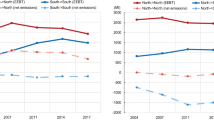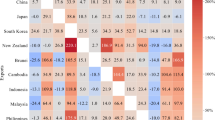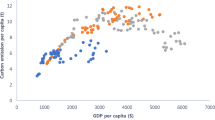Abstract
Most industrialized countries are net importers of carbon emissions, that is, they release fewer emissions for the production of their total exported goods and services than the amount generated (by their trading partners) for producing their total imported goods and services1,2,3,4,5,6,7,8. But what do such carbon trade-deficits imply in terms of global CO2 emissions and the design of carbon trade-policies? Drawing on trade theory, this Perspective argues that a deeper understanding of these observed net emission transfers is required to assess how international trade affects global emissions and proposes a method to disentangle the underlying determinants of such transfers.
This is a preview of subscription content, access via your institution
Access options
Subscribe to this journal
Receive 12 print issues and online access
$209.00 per year
only $17.42 per issue
Buy this article
- Purchase on Springer Link
- Instant access to full article PDF
Prices may be subject to local taxes which are calculated during checkout


Similar content being viewed by others
References
Davis, S. J. & Caldeira, K. Consumption-based accounting of CO2 emissions. Proc. Natl Acad. Sci. USA 107, 5687–5692 (2010).
Peters, G., Minx, J. Weber, C. L. & Edenhofer, O. Growth in emission transfers via international trade from 1990 to 2008. Proc. Natl Acad. Sci. USA 108, 8903–8908 (2011).
Guan, D., Peters, G., Weber, C. L. & Hubacek, K. Journey to world top emitter – an analysis of the driving forces of China's recent CO2 emissions surge. Geophys. Res. Lett. 36, L04709 (2009).
Li, Y. & Hewitt, C. N. The effect of trade between China and the UK on national and global carbon dioxide emissions. Energ. Policy 36, 1907–1914 (2008).
Pan, J., Phillips, J. & Chen, Y. China's balance of emissions embodied in trade: Approaches to measurement and allocating international responsibility. Oxford Rev. Econ. Pol. 24, 354–376 (2008).
Peters G. P. & Hertwich, E. G. CO2 embodied in international trade with implications for global climate policy. Environ. Sci. Technol. 42, 1401–1407 (2008).
Peters, G. P. & Hertwich, E. G. Post-Kyoto greenhouse gas inventories: Production versus consumption. Climatic Change 86, 51–66 (2008).
Peters, G., Weber, C. L., Guan, D. & Hubacek, K. China's growing CO2 emissions - a race between increasing consumption and efficiency gains. Environ. Sci. Technol. 41, 5939–5944 (2007).
Leontief, W. Domestic production and foreign trade: The American capital position re-examined. Proc. Am. Phil. Soc. 97, 332–49 (1953).
Leamer, E. E. The Leontief paradox, reconsidered. J. Polit. Econ. 88, 495–503 (1980).
Dietzenbacher, E. & Mukhopadhyay, K. An empirical examination of the pollution haven hypothesis for India: Towards a green Leontief paradox? Environ. Resour. Econ. 36, 427–449 (2007).
Caldeira, K. & Davis, S. J. D. Accounting for carbon dioxide emissions: A matter of time. Proc. Natl Acad. Sci. USA 108, 8553–8534 (2011).
Fischer, C. Trade's growing footprint. Nature Clim. Change 1, 146–147 (2011).
The Cost of Trade. The Economist (26 April 2011); available via http://go.nature.com/y3KOZk
Harrigan, J. Technology, factor supplies, and international specialization: Estimating the neoclassical model. Am. Econ. Rev. 87, 475–94 (1997).
Clark, D. West Blamed for Rapid Increase in China's CO2 . The Guardian (23 February 2009); available via http://go.nature.com/XeDZvY
Deardorff, A. V. & Hakura, D. S. in Trade and Wages: Leveling Wages Down? (eds Bhagwati, J. & Kosters, M. H.) 76–107 (AEI, 1994).
Copeland, B. & Taylor, M. S. Trade, growth, and the environment. J. Econ. Lit. 42, 7–71 (2004).
Ismer, R. & Neuhoff, K. Border tax adjustment: A feasible way to support stringent emission trading. Eur. J. Law Econ. 24, 137–164 (2007).
Elliott, J. et al. Trade and carbon taxes. Am. Econ. Rev. 100, 465–469 (2010).
Steckel, J., Kalkuhl, M. & Marschinski, R. Should carbon-exporting countries strive for consumption-based accounting in a global cap-and-trade regime? Climatic Change 100, 779–786 (2010).
Hoel, M. Efficient climate policy in the presence of free-riders. J. Environ. Econ. Manag. 27, 259–274 (1994).
Jakob, M., Marschinski, R. & Hübler, M. Between a Rock and a Hard Place: A Trade-Theory Analysis of Leakage under Production- and Consumption-Based Policies (EAERE Annual Conference, Rome, 2011); available via http://go.nature.com/dEzsRI
Vanek, J. The factor proportions theory: The n-factor case. Kyklos 21, 749–756 (1968).
Leamer, E. E. Factor-supply differences as a source of comparative advantage. Am. Econ. Rev. 83, 436–439 (1993).
Helpman, E. The factor content of foreign trade. Econ. J. 94, 84–94 (1984).
Helpman, E. & Krugman, P. Market Structure and Foreign Trade (MIT Press, 1985).
Maskus, K. E. A test of the Hecksher-Ohlin-Vanek theorem: The Leontief commonplace. J. Int. Econ. 19, 201–212 (1985).
Bowen, H. P., Leamer, E. E. & Sveikauskas, L. Multicountry, multifactor tests of the factor abundance theory. Am. Econ. Rev. 77, 791–809 (1987).
Estevadeordal, A. & Taylor, A. M. A century of missing trade? Am. Econ. Rev. 92, 383–393 (2002).
Harrigan, J. in The Handbook of International Trade (eds Choi, K. E. & Harrigan, J.) 85–118 (Wiley, 2003).
Markusen, J. R. Factor movements and commodity trade as complements. J. Int. Econ. 14, 341–356 (1983).
Helpman, E. The structure of foreign trade. J. Econ. Perspect. 13, 121–44 (1999).
Davis, D. R. & Weinstein, D. E. International trade as an “integrated equilibrium”: New perspectives. Am. Econ. Rev. 90, 150–154 (2000).
Hall, R. E. & Jones, C. I. Why do some countries produce so much more output per worker than others? Q. J. Econ. 114, 83–116 (1999).
Hakura, D. Why does HOV fail? The role of technological differences within the EC. J. Int. Econ. 54, 361–82 (2001).
Deardorff, A. V. The general validity of the Heckscher-Ohlin theorem. Am. Econ. Rev. 72, 683–94 (1982).
Davis, D., Weinstein, D. E., Bradford, S. C. & Shimpo, K. Using international and Japanese regional data to determine when the factor abundance theory of trade works. Am. Econ. Rev. 87, 421–46 (1997).
Trefler, D. The case of the missing trade and other mysteries. Am. Econ. Rev. 85, 1029–46 (1995).
Bernstein, J. & Weinstein, D. E. Do endowments predict the location of production? Evidence from national and international data. J. Int. Econ. 56, 55–76 (2002).
Choi, Y-.S. & Krishna, P. The factor content of bilateral trade: An empirical test. J. Polit. Econ. 112, 887–914 (2004).
Maskus, K. E. & Nishioka, S. Development-related biases in factor productivities and the HOV model of trade. Can. J. Econ. 42, 519–553 (2009).
Reimer, J. Global production sharing and trade in services of factors. J. Int. Econ. 68, 384–408 (2006).
Trefler, D. & Zhu, S. C. Beyond the algebra of explanation: HOV for the technology age. Am. Econ. Rev. 90, 145–149 (2000).
Acknowledgements
We want to thank J. Steckel for discussions and general support. Further comments from O. Edenhofer, J. Siegmeier and J. Minx are gratefully acknowledged. K. Caldeira provided an extensive review that helped to remove several inaccuracies. We are also indebted to M. Wodinski for designing the figures and U. Kornek for assistance with the trade data. All remaining errors are those of the authors.
Author information
Authors and Affiliations
Corresponding author
Ethics declarations
Competing interests
The authors declare no competing financial interests.
Supplementary information
Supplementary Information
Supplementary Information (PDF 370 kb)
Rights and permissions
About this article
Cite this article
Jakob, M., Marschinski, R. Interpreting trade-related CO2 emission transfers. Nature Clim Change 3, 19–23 (2013). https://doi.org/10.1038/nclimate1630
Received:
Accepted:
Published:
Issue Date:
DOI: https://doi.org/10.1038/nclimate1630
This article is cited by
-
The narrowing gap in developed and developing country emission intensities reduces global trade’s carbon leakage
Nature Communications (2023)
-
Characteristics and transfer paths of CO2 emissions embodied in trade and China’s carbon reduction strategies
Environmental Science and Pollution Research (2023)
-
On the Interpretation and Measurement of Technology-Adjusted Emissions Embodied in Trade
Environmental and Resource Economics (2023)
-
Estimating the environmental and employment impacts of China’s value-added trade from the perspective of value chain routes
Environmental Science and Pollution Research (2022)
-
An environmentally extended global multi-regional input–output analysis of consumption-based and embodied import-based carbon emissions of Turkey
Environmental Science and Pollution Research (2022)



